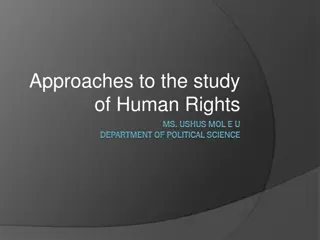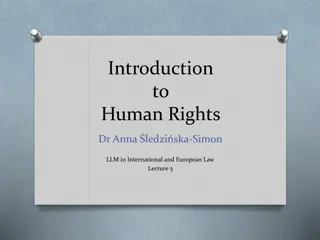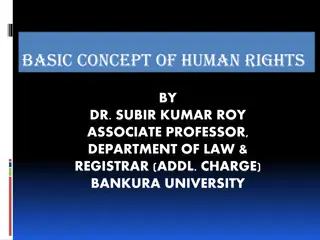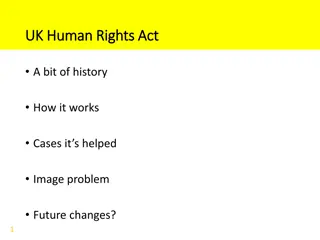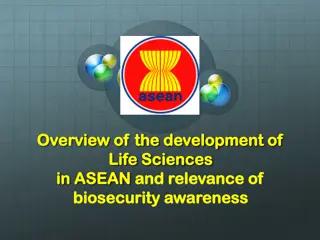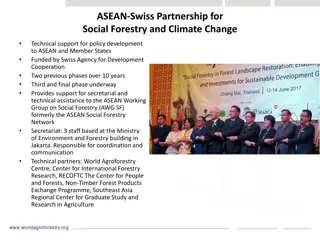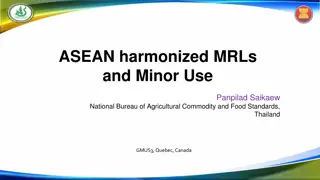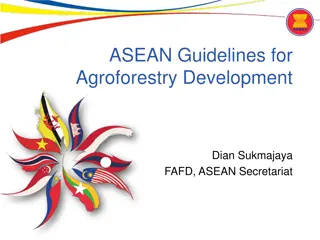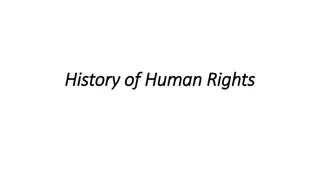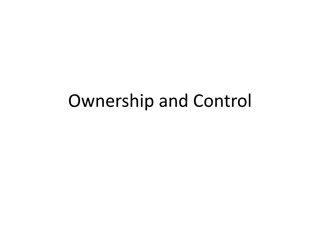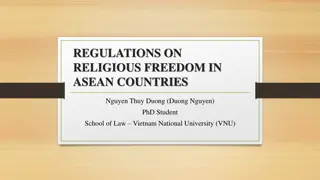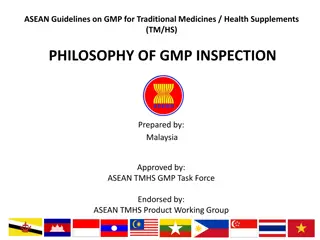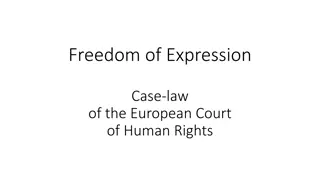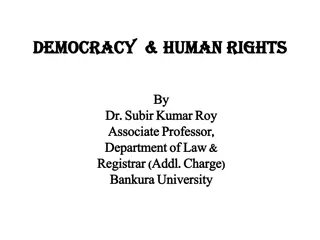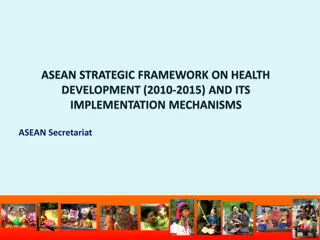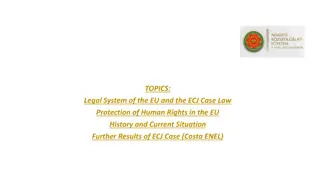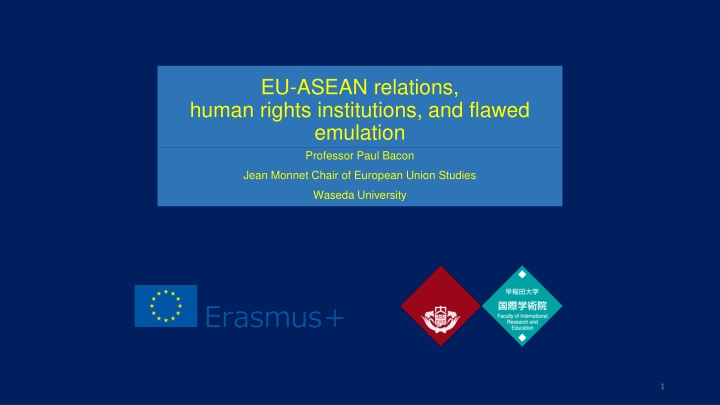
ASEAN's Approach to Human Rights Institutions
Explore the intricacies of ASEAN's 'ASEAN Way' and the challenges it poses to the development of human rights institutions within the region. Learn how the paradox of non-interference impacts ASEAN's ability to promote and protect human rights and democracy effectively.
Download Presentation

Please find below an Image/Link to download the presentation.
The content on the website is provided AS IS for your information and personal use only. It may not be sold, licensed, or shared on other websites without obtaining consent from the author. If you encounter any issues during the download, it is possible that the publisher has removed the file from their server.
You are allowed to download the files provided on this website for personal or commercial use, subject to the condition that they are used lawfully. All files are the property of their respective owners.
The content on the website is provided AS IS for your information and personal use only. It may not be sold, licensed, or shared on other websites without obtaining consent from the author.
E N D
Presentation Transcript
EU-ASEAN relations, human rights institutions, and flawed emulation Professor Paul Bacon Jean Monnet Chair of European Union Studies Waseda University 1
The ASEAN Way and ASEAN centrality ASEAN has demonstrated considerable framing power in two domains by promoting the concept of the 'ASEAN Way'. Firstly, in the intra-ASEAN peace and security domain, it has developed a security community-like culture among its members states. This is based on six core constitutive ASEAN norms, the most important of which are sovereignty, non-interference and territorial integrity. Secondly, it has projected norms such as the non-use of force and pacific settlement of disputes outward into the Asia-Pacific. These norms are reflected in the institutionalization of international relations in the region around ASEAN centrality , in arrangements such as ASEAN + 3 and the ASEAN Regional Forum. We focus on the first of these domains, intra-ASEAN relations, because this is more explicitly connected to issues of democracy and human rights promotion. 9
An ASEAN paradox? Within this first domain, ASEAN has unfortunately so far failed in its attempts to develop institutions which protect human rights. The ASEAN Way is itself a 'negative' institutional settlement. It is made up of a set of norms explicitly designed to limit aggressive behaviour and mutual interference, rather than promote more ambitious goals of regional governance. This has ultimately prevented ASEAN from creating meaningful practices and mechanisms through which to institutionalize the promotion and protection of human rights and democracy. There is an 'ASEAN paradox', as such. There have been genuine attempts to build rigorous practices and mechanisms of mutual scrutiny in the area of human rights and democracy, which some feel are necessary to round out and develop the full potential of the organization. Ultimately, however, these attempts have come up against the most important ASEAN norm, that of non-interference: Some ASEAN member governments fear that any departure from non-interference... could ruin the grouping. But a flexible attitude towards sovereignty is also crucial to its ability to deal with ... transnational challenges. This is the essential paradox of contemporary Southeast Asian regionalism: the very norms and practices that have kept ASEAN viable have also limited [its] effectiveness in dealing with external and global challenges (Acharya 2014: 264). 10
Norm entrepreneur member states During the late 1990s and early 2000s, several ASEAN states democratized, or developed more robust democratic and democracy promotion credentials. At this time there was a significant and genuine attempt to build a stronger human rights and democracy promotion profile for the organization. Indonesia, the Philippines, Thailand and sometimes Malaysia were the norm entrepreneurs driving this attempt. But these states eventually either: suffered a decline in their own democratic credentials; became less concerned with trying to promote human rights and democracy; or met with significant opposition from recalcitrant/reluctant states. 11
ASEAN and human rights institutions: organized hypocrisy? 1 In the last 20 years, ASEAN has created the ASEAN Charter (AC), the ASEAN Declaration of Human Rights (ADHR) and the ASEAN Intergovernmental Commission on Human Rights (AICHR). Ultimately, as I argue below, these are compromise texts and institutions that represent an exercise in organized hypocrisy . Organized hypocrisy exists when there is a contradiction/lack of fit/disjuncture between the logic of appropriateness and the logic of consequences in the case under consideration. Stephen Krasner introduced the concept of organized hypocrisy to international relations theory. According to him, all political and social environments are characterized by two logics of action, a logic of expected consequences, and a logic of appropriateness. Logics of consequences see political action and outcomes, including institutions, as the product of rational calculating behaviour designed to maximize a given set of preferences. Logics of appropriateness understand political action as a product of rules, roles, and identities that stipulate appropriate behaviour in given situations. 12
ASEAN and human rights institutions: organized hypocrisy? 2 The two logics are not mutually incompatible, but their importance varies across environments. For Krasner, crucially, the international system is an environment in which the logics of consequences dominate the logics of appropriateness. Often, efforts to employ a logic of appropriateness in international relations underestimate the importance of power and self-interest. Logics of appropriateness also overemphasize the impact of international, as opposed to domestic, roles and rules. Krasner argues that domestic roles and rules are usually more important. In our case, there is a lack of fit between the logic of appropriateness that can be seen in ASEAN- level human rights documents and pronouncements, and the logic of consequences at the member-state level, where states want to uphold the norm of non-interference. ASEAN member states are advancing a logic of appropriateness associated with democracy and human rights. But the underlying logic of consequences for individual member states means that in reality, they have a strong incentive to ensure that ASEAN human rights documents, mechanisms and institutions are ultimately weak, and have no real powers of scrutiny or punishment. 13
The misplaced temptation for ASEAN to emulate the EU 1 The EU has a vision of the world as a world of regions. This is reflected in, for example, the EU s Global Strategy, an important document which identifies five key objectives, one of which is a world of responsible regions . The EU, therefore, invites other regions to emulate it. The EU explicitly seeks reciprocal inspiration . Jetschke and R land also argue that members of ASEAN continuously engage in cooperation rhetoric and devise cooperation projects because they emulate the European integration project (Jetschke and Ruland 2009: 181, see also Jetschke and Murray 2012). Philomena Murray also claims that the EU has consistently been perceived as a model for ASEAN s institutional development (p.522). Murray argues that ASEAN s adoption of some EU nomenclature (names) for new institutions and processes can be regarded simply as the setting of ambitious goals to create a new dynamism (p.523). But she also warns that if the new institutions cannot be operated on the same assumptions as their EU counterparts, there may set in a corrosive sense of frustration and disillusionment (p.523). 14
The misplaced temptation for ASEAN to emulate the EU 2 Murray warns that we should identify a zone of discretion . This means that, where possible, we should by all means set ambitious but realistic goals for ASEAN s greater integration (p.524). But she also warns of the risk of adopting ambitious structures that could well prove to be less than appropriate to ASEAN in terms of short- to medium-term achievements (p.529). We suggest that this is in fact what happened when ASEAN committed itself to creating human rights declarations, commissions and mechanisms, tempted by an attempt to emulate the EU. We suggest that the real puzzle is not why leaders of a group of states with poor human rights records such as the ASEAN member states would ultimately be reluctant to develop a mutually intrusive and punitive human rights mechanism. This is not difficult to understand. The puzzle is why the ASEAN logic of appropriateness associated with human rights and democracy became detached from, and ran out ahead of, the logic of consequences. We suggest below that there are three main reasons; First, the role and influence of the ASEAN norm entrepreneur states; Second, the functional imperative to institutionalize more issues at the ASEAN level to address the growing number of transnational threats besetting ASEAN states in the 2000s. A third explanation is offered by Katsumata (2009), and Jetschke and Ruland (2009) (among several others), who argue that ASEAN has felt strong pressure to emulate the European Union. 15
ASEAN and human rights: collective agreement, or genuine contestation? 1 Poole suggests that there was collective agreement to proactively regionalize the idea of human rights and democracy in order to address and absorb external human rights pressure. For her, ASEAN states never actually wanted to fundamentally challenge traditional ASEAN norms. But they were concerned about external regional legitimacy, and wanted to be seen as being concerned about human rights, and to make human rights part of official regional dialogue, precisely so that it would remain a regional issue (Poole 2015: 371). We agree with Poole that organized hypocrisy in the texts and institutions was indeed the final outcome. But we assert that there WAS genuine contestation between different types of state. The norm entrepreneurs genuinely wanted to create these institutions, and for them to succeed. Ultimately, however, there was contestation by more reluctant states, and later, a loss of credibility and enthusiasm by the norm entrepreneur states. This was reflected, and is indeed the main reason for, the compromises eventually to be found in the ASEAN texts and institutional mechanisms. 16
ASEAN and human rights: collective agreement, or genuine contestation? 2 Poole suggests that ASEAN demonstrated framing power by smoothly co- opting, regionalizing and diluting the force of the global human rights and democracy script. We suggest instead that the process has been messy, conflictual, and has resulted in significant and justified criticism of ASEAN. ASEAN has ultimately not been able to deliver meaningful texts, mechanisms and institutions, and therefore has not been able to demonstrate credible framing power as a human rights and democracy- protecting actor. Organized hypocrisy has been the outcome. Also, the EU has been a significant and sometimes unwitting driver of and inspiration for, these ultimately failed attempts by ASEAN at inter-regional emulation of the EU s human rights-related logic of appropriateness. 17
ASEAN human rights institutions: a flawed emulation of the EU? As well as the ASEAN paradox, we can add a second awkward possibility. This is that the messy institutional compromises that have emerged from the ASEAN process are themselves the unintended consequence of the framing power of the European and global human rights and democracy promotion scripts. European promotion of a world of cooperative and responsible regions, and of the need for regional human rights mechanisms, is an important part of the reason why these unsatisfactory ASEAN documents exist. ASEAN was inspired to emulate these practices, documents and institutions. There would not have been a drive to create these documents and institutions by the norm entrepreneur states. And it would not then have been necessary to dilute the impact of the declaration and the commission through organized hypocrisy, if this flawed emulation not been attempted in the first place. 18
Peace and Stability without Democracy: Development of the ASEAN Security Community The Association of Southeast Asian Nations (ASEAN) was founded on 8 August 1967 by Indonesia, Thailand, Malaysia, Singapore and the Philippines. These Southeast Asian countries were caught in a tug of war between the great powers. They also faced internal struggles in their resistance to Communist movements, and challenges from other countries in the region, in particular from Vietnam, to the stability of their young governments. After the end of the Second World War and the tide of decolonisation started at the Bandung Conference in 1955, Southeast Asia thus experienced a period of transition. 19
ASEAN: defensive or minimalist institutionalization The context of the emergence of ASEAN explains the foundations upon which it is built, as well as its institutional evolution. It can be said that Asia has historically never been a region of institution-building (Acharya 2009: 174) and ASEAN confirms this trend. The regionalism championed by ASEAN is consistent with this limited vision of nationalism and nation-state consolidation served through regional cooperation (Acharya 2009: 175), The leaders of its five founding members set up an Association to fight common threat, both internal and external. ASEAN was designed as a minimalist organisation, wary of too much institutionalisation, relying on respect of sovereignty and non-intervention in other states' internal affairs. ASEAN s limited mandate was to prevent further confrontation between the new states in the region, and to guarantee the sovereignty of their governments over their internal affairs. This could perhaps be characterised as negative, or defensive institutionalization. 20
ASEAN Norms: Defining Features of the ASEAN Way ASEAN is a regional ensemble explicitly founded upon a series of norms. Norms can be loosely defined as rules, patterns or accepted standards of behaviour. Some of these norms are widely shared amongst regional organisations and theorised in international relations, others are more specific to ASEAN. In his study of the role of norms in the shaping of Japan s national security policy, Peter Katzenstein establishes a distinction between two categories: legal norms, which are formal and rational principles enshrined in law, and social norms, which become mostly effective when informal social controls break down (Katzenstein 1996: 43). Acharya draws on this distinction to classify the norms which are valid in the ASEAN context. He identifies four norms of a legal-rational kind, and two of a socio-cultural kind. 21
The four legal-rational norms Acharya argues that legal-rational norms proceed from the principles of the Westphalian state system upon which all modern international and regional organisations are based, namely: the respect for state sovereignty, non-interference in the domestic affairs of other states, non-use of force in interstate relations and the pacific settlement of disputes (Acharya 2014: 22). ASEAN has enshrined these Westphalian norms, laid out in the United Nations Charter, in its core principles. The Bangkok Declaration of 8 August 1967 specifically mentions the United Nations Charter in its aims and purposes . The Bangkok Declaration also clearly underlines the importance of regional autonomy as well as non- interference in the internal affairs of its members. It also confines the ASEAN mandate to economic development and the upholding of peaceful relations, de-emphasizing the idea of supranational policy integration. ASEAN member states promote a culture of peaceful interaction and regional autonomy in an attempt to avoid domination by global powers. ASEAN member-states ruled out an intra-regional military pact, in an attempt to escape the security dilemma and avoid adopting a realist way of approaching regional politics. 22
The two socio-cultural norms Socio-cultural norms are effective as informal instruments of compliance, because they reflect a group s historical and cultural environment, and are specific to that group. In the case of ASEAN, these socio-cultural norms include: consultation (musyawarah), a process of informal discussions occurring ahead of the formal negotiations intended to develop general agreement; and the ensuing consensus (mufakat), mean[ing] that policy initiatives can only arise on the basis of a common denominator (Leifer 1989: 27). These processes are highly elitist decision-making mechanisms that preclude the possibility of the majority of states imposing views on the minority (Hoang 1996: 67) But it can also be argued that this process is not really a democratic process because decisions are made first, and then people are told about it (Siregar 1997). This established and distinctive modus operandum of ASEAN stresses informality, inclusiveness and consultation to reach a consensus in dispute resolution. It is claimed to be unique to Southeast Asia's cultural heritage (Acharya 2014: 44). This decision-making process underpins the ASEAN Way and it is claimed that this is what sets it apart from other regional organisations. 23
Towards a greater role for human rights and democracy within ASEAN ASEAN was initially not intended to engage with human rights concerns. The ASEAN grouping started to show interest in those issues from the 1990s onwards, eventually leading to the unexpected and protracted (Davies 2014: 108-109) institutional development of an ASEAN human rights personality. After the end of the Cold War, ASEAN became less resistant to dialogues over questions of transnational security and human rights, both within the grouping and with outside powers. With the shifting global power balance, intra-ASEAN differences are more about the necessity and scope of collective regional action in areas such as peacekeeping and on issues such as human rights and democracy (Acharya 2009: 176). The momentum around human rights issues was a response to a series of events. The 1997 Asian financial crisis pushed ASEAN to reinvent its approach to regionalism and to the principle of non-intervention in particular. Internal crises and external pushes provided a real-life test of the grouping's engagement with human rights issues. ASEAN s initial interest in human rights was consolidated through engagement with ad hoc transnational threats. This eventually led to attempts at the institutionalisation of human rights norms in the ASEAN space. 24
Flexible engagement? Surin Pitsuwan, Thai Foreign Minister (1997-2001) made a significant statement against non-intervention in 1998-1999. He and his deputy, Sukhumbhand Paribatra, pushed for the adoption by ASEAN of a doctrine of flexible engagement . They argued that, no matter how useful ASEAN s traditional policy of non- intervention had been in its formative years, it was now time to move beyond it and to modify it. This would allow it to play a constructive role in preventing or resolving domestic issues with regional implications . Such domestic issues could include the collapse of a national government through economic mismanagement, as had been the case for Thailand in the 1997 crisis. Or the creation of regional threats and instabilities, such as the management of post-Cyclone Nargis recovery efforts. 25
Disagreements over flexible engagement 1 These views created divisions amongst ASEAN members, laying bare fundamental differences of opinion over ASEAN s identity and core norm of non-intervention. Philippines Minister Domingo Siazon openly sided with Thailand and pushed for flexible engagement as laying the basis for an EU-style ASEAN, where debate and confrontation lead to improvement. Other country leaders, in particular Malaysia s Foreign Minister Abdullah Badawi, firmly rejected this view. Badawi feared that issues formerly dealt with at a bilateral level would spiral needlessly into regional concerns for ASEAN. This would open the door to meddling by external powers, thus undermining ASEAN s regional autonomy. However, the eminent Singaporean diplomat Tommy Koh highlighted the need for ASEAN to overcome its reluctance to institutionalise, and supplement the ASEAN Way of trust-building, consensus and consultation through the creation of institutions (Koh 1998). And as Suharto s New Order administration was replaced in 1998 by Reformasi and its more open socio- political environment, Indonesia moved into the reformist camp and proposed to build an ASEAN security community . This initially included such bold ideas as promoting democracy as one of the basic ASEAN norms, and creating a regional human rights mechanism (Indonesia Department of Foreign Affairs 2003). 26
Disagreements over flexible engagement 2 These debates on the new regionalism ASEAN should embody took on various forms. Proposals sometimes borrowed from other institutional models, and sometimes tried to stick more closely to the region s specificities. The economic crisis which unleashed these discussions had also led to a loss of legitimacy of the authoritarian regimes in the region. This coincided with a period of pro-democracy change in some of the driver states of ASEAN. This heavily influenced the deliberations, creating the momentum for developing a human rights framework in the grouping. However, ASEAN members clashed when it came to building a forward-looking human rights perspective. Some of the boldest ideas, such as flexible engagement or an ASEAN security community as envisaged by Indonesia, did not ultimately survive ASEAN s limited consensus-building process. But a string of events in the late 1990s and 2000s did test this attempt to limit the horizons of ASEAN with regard to human rights. 27
The emerging transnational security and human rights imperative A growing number of voices acknowledged that the issues of democracy and human rights are those we have to increasingly deal with in our engagement with the outside world (Pitsuwan, Straits Times, 1998: 23). Indeed, the common characteristics of most of the new threats that destabilised Southeast Asian societies during that period, and shook the foundations of ASEAN, were their unpredictability, their global reach, and their transnational nature. Acharya (2014) identifies the major transnational crises ASEAN faced in the early 2000s: the Bali bombings (2002), the severe acute respiratory syndrome (SARS) pandemic (2002), the Indian Ocean tsunami (2004), and the repeated haze from Indonesia (1997, 2006, 2013). The transnational nature of these crises is evident, amplified by regional and global interconnectedness; interdependence and globalization serve as transmission belts for these threats (Acharya 2007: 23). This awareness led to a major shift in the core function of ASEAN. Initially set up to protect its members from domestic insurgency or outside invasion, these crises underscored the fact that the most dangerous challenges in the post-Cold War era come from acute transnational security crises linked to human security and human rights. 28
Myanmar as human rights catalyst(?) Several crisis situations in Myanmar served as strong catalysts for normative dialogue on human rights and humanitarian intervention within the region. The first small dent in the non-interference doctrine came in 2006, when Burma passed on its rotational right to the chairmanship of ASEAN, following pressure from other members and the international community. The second came in 2007 following the violent repression by the Burmese military junta of the saffron uprising led by Buddhist monks. the Foreign Ministers of the other ASEAN countries officially strongly condemned this display of violence and urged Burma to exercise restraint and seek a political solution. Finally, the most significant strides towards favouring human rights concerns over non-intervention came in the aftermath of Cyclone Nargis. ASEAN s achievements in handling Cyclone Nargis should not be overstated, however. Although it was a breakthrough in many regards, it should be noted that it does not fall within the remit of classical human rights interventions, but within the category of the much less contentious disaster relief framework, as a human security intervention. Thus, whilst ASEAN s response to intramural affairs changed considerably over time, from a certain indifference at the time of constructive engagement to a more hands-on involvement in the aftermath of Nargis, the non-interference doctrine remains at the heart of the grouping s relations. 29
ASEANs human rights institutions 1 How much of the human rights momentum experienced in the late 1990s and early 2000s has thus been incorporated into the practice of ASEAN? How and how much have human rights been incorporated into ASEAN s institutions? The codification of human rights within ASEAN is in itself counter-intuitive, given the grouping s core principles, non-democratic governments and wariness of institutionalization. However, driven by ASEAN s three norm entrepreneurs in the early 2000s, an incremental process of community-building aiming at fostering caring societies gradually led to the creation of human rights instruments (ASEAN Vision 2020, 1997; ASEAN Bali Accords II, 2003). The 2004 draft of the ASEAN Security Community Plan of Action submitted by Indonesia urged the creation of an ASEAN Regional Commission on Human Rights. 30
ASEANs human rights institutions 2 The ensuing Vientiane Action Programme, adopted in November 2004 at the 10thASEAN Summit, substantially watered down this proposal and replaced it with the idea of Establishing a network among existing human rights mechanisms . Despite this set-back, the latter idea of linking human rights institutions was supplemented with other new commitments on the human rights front. These included the agreement amongst ASEAN members to share human rights-related information and to establish a number of sectoral bodies, for instance an ASEAN commission for the promotion and protection of the rights of women and children (ASEAN 2004). Furthermore, three years later, the Eminent Persons Group s recommendations on the ASEAN Charter included the creation of an ASEAN Human Rights Body, which was approved in the final text of the Charter (Article 14). Also, and more importantly, the ASEAN Charter enshrined the promotion and protection of human rights as a fundamental principle under its articles 1 and 2. As a consequence, human rights violations can, since 2007, be considered as a breach of the Charter. However, the Charter simultaneously re-established the preeminence of its founding principles of non- interference and consensus-building, thus leaving the place of human rights needing to be defined more clearly. 31
ASEANs human rights institutions 3 In 2009, ASEAN established the ASEAN Intergovernmental Commission on Human Rights (AICHR) to promote human rights. By mid-2012, the Commission had drafted the ASEAN Human Rights Declaration, which was adopted unanimously by ASEAN members at the November 2012 meeting in Phnom Penh. Article 10 of the declaration directly endorses all the civil and political rights in the Universal Declaration of Human Rights [UDHR] , and these are detailed in Articles 11 25. Article 26 endorses all the economic, social and cultural rights in the Universal Declaration , which are then described in Articles 27 34. The ASEAN Human Rights Declaration also includes issues that the UDHR does not, by making explicit the: right to safe drinking water and sanitation ; right to a safe, clean and sustainable environment ; right to protection from discrimination in treatment for people suffering from communicable diseases, including HIV/AIDS ; the right to development; and the right to peace. 32
Criticisms of ASEAN human rights institutions 1 However, the Commission has been widely criticized for a lack of transparency, and for failure to consult with ASEAN civil society during the drafting process. For example, Amnesty International, publishing a letter signed by 64 Asian grassroots, national and regional, as well as international civil society, groups, claimed that: Civil society groups have repeatedly expressed grave concerns over both the drafting process and the substance of the Declaration since the initiative began. The AICHR met with regional civil society only towards the very end of the process and ignored most of their recommendations. Some individual AICHR representatives held consultations with civil society groups nationally, but such meetings were mostly ineffective. In some countries, no consultations were held at all. Most of the drafting process was conducted in secret and texts were rarely shared and never publicized. (Amnesty International 2012) The Declaration itself has also been fiercely criticized by ASEAN civil society and other major international human rights organizations such as Human rights Watch, the US State Department, and the UN High Commissioner for Human Rights. 33
Criticisms of ASEAN human rights institutions 2 The main problems with the document, from the perspectives of these organizations, can be found in paragraphs 6, 7 and 8. Paragraph 6 of the Declaration states that: The enjoyment of human rights and fundamental freedoms must be balanced with the performance of corresponding duties as every person has responsibilities to all other individuals, the community and the society where one lives (emphasis added). ] Paragraph 7 argues that: the realisation of human rights must be considered in the regional and national context bearing in mind different political, economic, legal, social, cultural, historical and religious backgrounds (emphasis added). Paragraph 8 argues that: The exercise of human rights and fundamental freedoms shall meet the just requirements of national security, public order, public health, public safety, public morality, as well as the general welfare of the peoples in a democratic society (emphasis added). 34
Criticisms of ASEAN human rights institutions 3 Human Rights Watch went so far as to describe the document as a declaration of government powers disguised as a declaration of human rights (Human Rights Watch 2012). ASEAN civil societies have noted that: The Declaration fails to include several key basic rights and fundamental freedoms, including the right to freedom of association and the right to be free from enforced disappearance (Human Rights Watch 2012). The US Department of State and the United Nations High Commissioner for Human Rights both welcomed the Declaration, but with substantive reservations. The US State Department stated that it supported the attempt to develop a regional human rights declaration in principle . But it expressed concern with regard to the the use of the concept of cultural relativism stipulating that domestic laws can trump universal human rights, incomplete descriptions [of rights] that are mentioned elsewhere, introducing novel limits to rights, and language that could be read to suggest that individual rights are subject to group veto (US State Department 2012). The UN High Commissioner for Human Rights also welcomed the renewed commitment by leaders of the Association of Southeast Asian Nations to universal human rights norms . However, she warned that it is essential that ASEAN ensures that any language inconsistent with international human rights standards does not become a part of any binding regional human rights convention (UNOHCHR 2012). 35
Criticisms of ASEAN human rights institutions 4 Two key points emerge from the discussion above: first, that civil society has not been adequately consulted, and second, that the ADHR is a backward step. It omits important rights which are enumerated in the UDHR and also contains a number of ill-defined qualifications that could be used to justify restrictions on those human rights which are mentioned in both the UDHR and the ADHR. This clearly raises the question as to why anybody should take seriously a Declaration which contains weaker standards than the UDHR. Davies argues that ASEAN s approach to human rights holds little to comfort those who favour a more forceful regional commitment to rights, or indeed democracy . And also that there is nothing that suggests a shift away from intergovernmental approaches to the workings of ASEAN s regional order, so often identified as the biggest impediment to more robust regional oversight (Davies 2013: 401). 36
Criticisms of ASEAN human rights institutions 5 Asplund has argued that the three main advocates for the establishment of the AICHR were Indonesia, the Philippines and Thailand. These three states have also been the most (and arguably the only) democratic members of ASEAN. Cambodia, Laos, Myanmar and Vietnam were laggards and opponents of the moves to create stronger ASEAN human rights institutions. Malaysia and Singapore were initially supportive of the more democratic states, but adjusted their positions over time to reflect the interests of the laggard/opponent states (Asplund 2014: 9 10). Davies notes that: At this juncture it would be very hard to provide arguments that certain member states that have signed up to the ASEAN Charter and AICHR have in any way internalised norms of human rights, even in the vague and generalised sense that ASEAN speaks of them. (Davies 2013: 399). 37
Criticisms of ASEAN human rights institutions 6 We can therefore see that the AICHR and the ADHR constitute a significant backward step from the content of the original UN human rights documents. And also that civil society was not adequately consulted as part of the process to create the commission and the declaration. What is also clear is that ASEAN had significant internal divisions, between those more democratic states who favoured the development of stronger ASEAN human rights institutions, and the more recalcitrant authoritarian and soft authoritarian regimes, who are keen to limit such developments. Furthermore, the intergovernmental approach adopted towards these issues by ASEAN means that there is not likely to be significant progress in developing more robust human rights institutions in the short to medium term. Moreover, it has been Indonesia, the Philippines and Thailand who have been the most important norm entrepreneurs and drivers of the attempt to make ASEAN a more credible actor with regard to democracy and human rights over the last decade. However, all three have suffered significant recent relapses in their democratic or democracy- promoting credentials. 38
Evaluating levels of democracy and human rights protection in the ASEAN member states 1 If we want to better understand the potentials of and constraints on ASEAN as an embodiment and promoter of democratic and human rights standards at the regional level, it is necessary to gain a perspective on the human rights profiles of the individual ASEAN member states. ASEAN is widely acknowledged to be an intergovernmental organization, and therefore, to a substantial degree, the product of the domestic positions of its constituent members. Please consult Table 1, in the slide below. Moving from top to bottom, we have listed ASEAN member states in terms of their rankings, and in particular their scores out of 100, in the annual Freedom House Freedom in the World surveys. Based on this analysis, there are clearly three clusters of states in the 2019 rankings; Indonesia and the Philippines, with scores around the 60 mark, Malaysia and Singapore, with scores around the 50 mark, and the other 6 member states, all with scores of 31 or below. 39
ASEAN member states ranked by Freedom in the World score and status, 2000 and 2019 FHScore (100) Electoral democracy PR CL FreedomRating FHStatus (2019) FHStatus (2000) State 62 Y INDONESIA 2 4 3 Partly Free Partly Free 61 Y PHILIPPINES 3 3 3 Partly Free Free 52 N MALAYSIA 4 4 4 Partly Free Partly Free 51 N SINGAPORE 4 4 4 Partly Free Partly Free 31 N MYANMAR 5 5 5 Partly Free Not Free 30 N THAILAND 7 5 6 Not Free Free 29 N BRUNEI 6 5 5.5 Not Free Not Free 26 N CAMBODIA 6 5 5.5 Not Free Not Free 20 N VIETNAM 7 5 6 Not Free Not Free 14 N LAOS 7 6 6.5 Not Free Not Free 40
Evaluating levels of democracy and human rights protection in the ASEAN member states 2 Importantly, not a single ASEAN member state is considered to be Free, a status which corresponds to that of liberal democracy in the rankings. Indonesia, the Philippines, Singapore, Malaysia and, somewhat surprisingly, Myanmar, are all considered to be Partly Free. Furthermore, only two states, Indonesia and the Philippines, are even considered to be electoral democracies. This means states that have meaningful and periodic elections, even if they do not have very impressive scores for the protection of civil liberties. Additional detail has also been provided on the 2019 Political Rights (PL) and Civil Liberties (CL) scores of each of the member states. 41
Evaluating levels of democracy and human rights protection in the ASEAN member states 3 We have also included information on the status of each member state in the Freedom in the World rankings for 1999-2000. It is important to note that at this time two countries, the Philippines and Thailand, were considered to be free, with Indonesia not far behind. This information helps to support the claim that these three countries were significant drivers of the ASEAN move towards the creation of a greater human rights personality, from the late 1990s through until the mid-2000s. At the turn of the century, there were two Free states, three Partly free states, and five Not Free states. This is still not a particularly strong freedom profile for the region, but it is a significantly stronger profile than that which exists today. To give some brief comparative context, all 27 member states of the European Union bar one, Hungary, are currently ranked as Free. If Hungary were to appear in this table, it would be ranked top by some distance, comfortably in a different class to all ASEAN member states, with a raw score of 70 out of 100. 42
Evaluating levels of democracy and human rights protection in the ASEAN member states Finally, we have compiled data on how many of the 18 major UN human rights instruments (conventions and protocols) have been ratified by each of the ASEAN member states. You can see these tables in the required reading for this topic lecture. Again, ASEAN member states score poorly, in both absolute and comparative terms. Six out of ten ASEAN member states have ratified one half or fewer of the 18 major instruments, and there are no ASEAN member states in the top tier of ratifying states (UNHCR 2019). This profile compares unfavourably with that of regions such as Central America, Europe, South America, and West Africa, where a very significantly higher proportion of states have ratified 10 or more instruments (UNHCR 2019). 43
Explaining the gap between appropriateness and consequences in ASEAN human rights institutions 1 In the previous section of the slides, we saw that ASEAN member states, individually and collectively, have poor human rights records, in both absolute and comparative terms, across a range of issues. To turn the question around, it might perhaps be asked why anyone, including the EU, might hope or expect that a group of such states would produce a robust, legally binding, mutually intrusive and perhaps even punitive human rights architecture. The fact that ASEAN does not have a good human rights record is often regarded as a puzzle. However, we suggest that the fact that ASEAN does not possess such mechanisms is not a puzzle per se. It is surely highly predictable that a regional organization containing a group of member states with such poor human rights records would obviously not agree to intrusive, binding or punitive mechanisms. It is equally predictable what would happen if a group of states with poor human rights records found itself in a position where a regional organization had already over-committed them to a regional human rights script, or logic of appropriateness. These states would pursue a strategy of organized hypocrisy. They would continue to talk about human rights standards, but they would make sure that any institutions which were created as a result were not intrusive, binding or punitive. We would expect there to be a gap/lack of fit between an ASEAN-level logic of appropriateness suggesting that robust regional human rights mechanisms should exist, and a logic of consequences dictating that the leadership elites of member states would in fact be highly reluctant to create such robust mechanisms. 44
The REAL puzzle The real puzzle, rather, is why we might expect that ASEAN would possess such mechanisms. To put it another way, we might ask how and why the ASEAN human rights logic of appropriateness was able to get out so far ahead, to become so detached, from the underlying reality of the logic consequences. The three reasons offered most often in the literature are: 1. the roles of the democratizing (at the time) norm entrepreneur states of Indonesia, the Philippines and sometimes Malaysia and Thailand (Asplund 2014 9-10; Dani 2008: 174; Davies 2014: 112; Dosch 2008: 84; Poole 2015: 360-63) 2. the functional imperative to institutionalize more issues at the ASEAN level to address the growing number of transnational threats besetting ASEAN states in a post-Cold war, post 1997 financial crisis world (Acharya 2013). 3. A third explanation is offered by Katsumata (among others), who argues that ASEAN members have mimetically been adopting the norm of human rights which is championed by the advanced industrialized democracies, motivated by their desire to be identified as advanced and legitimate (Katsumata 2010: 625). Jetschke and R land also argue that members of ASEAN continuously engage in cooperation rhetoric and devise cooperation projects because they emulate the European integration project (Jetschke and Ruland 2009: 181, see also Jetschke and Murray 2012). Poole also suggests that part of the impetus for setting up the human rights body may have been simply that it seemed appropriate, given the examples provided by other regions (Poole 2015: 369, emphasis added). 45
Explaining the gap between appropriateness and consequences in ASEAN human rights institutions 2 There were therefore two sets of unintended consequences of the logic of appropriateness getting too far ahead; Firstly, ASEAN member states needed to create a diplomatic strategy to address the position they had been put in, by the norm entrepreneur states. These norm entrepreneur states had over-committed both ASEAN and themselves to the global human rights and democracy promotion script, earlier in the process of ASEAN human rights institution-building. From that position, it would have been difficult for ASEAN and its member-states to openly repudiate or back away from the global human rights script. Equally, they were unable and or unwilling to live up to this human rights and democracy promotion script. As a result, they chose the option of organized hypocrisy; they nominally committed to the standards, but in practice did not live up to them. They made sure that these standards were not meaningfully and bindingly reflected in the new ASEAN institutions. Second, therefore, and as we have seen, the ADHR and the ASEAN Charter are unsatisfactory documents, which formally codify this organized hypocrisy. On one hand, the institutions and documents make many commitments which the signatories do not adhere to. On the other, the documents contain articles contradictory to human rights (Articles 6, 7 and 8, discussed above). The analysis above and the various citations suggest that European rhetoric about and promotion of a world of cooperative and responsible regions, and about the need for regional human rights mechanisms, is be part of the reason why these unsatisfactory documents exist. There would not have been drive to create these institutions, and then a correction to mitigate their impact through organized hypocrisy, had this emulation not been such a strong imperative in the first place. 46
Explaining the gap between appropriateness and consequences in ASEAN human rights institutions 3 Jetschke and Katada have also argued that pressures to conform to international norms have prompted attempts at adaptation and emulation by Asian regional institutions, a process which symbolizes a departure from the ASEAN Way. They also ask whether these transfers are the outcome of legitimacy-driven mimicry, learning or competition, and [whether] these adoptions increase the effectiveness of ASEAN, and mitigate its implementation problems or prolong them (2017: 236). The norm entrepreneur states had initially tried to emulate these global and European standards by attempting to create human rights and democracy related institutions at the ASEAN level. Once they had done this, it was necessary for the laggard and swing states to regroup, and push back against the momentum created by the norm entrepreneur states. They needed to take back control and reASEANize the documents, institutions and mechanisms that emerged at the ASEAN level. As Poole notes in an important and original contribution to the literature, ASEAN is not a vacuum, and has its own cognitive priors, such as sovereignty and non-interference. These cognitive priors ultimately dictate limits to the amount of human rights-related intrusiveness member states are willing to endure, and officially sign up to. 47
Explaining the gap between appropriateness and consequences in ASEAN human rights institutions 4 Poole argues that the strategy of creating a human rights body to address concerns regarding external regional legitimacy did not fail. Instead, she argues that for some ASEAN member states, the strategy had in fact been successful: ASEAN had created a body which ostensibly addresses human rights concerns in the region, and makes human rights part of official dialogue, without fundamentally challenging ASEAN norms of sovereignty and non-interference. In other words, ASEAN made a normative statement without necessarily introducing or enhancing a normative standard (Poole 2015: 372-3). We agree with Poole that the leaders of ASEAN member states ultimately produced what we have called organized hypocrisy; committing to normative rhetoric without implementing a meaningful standard. But Poole further argues that most ASEAN states did not want to fundamentally challenge traditional ASEAN norms . Further, ASEAN was not seeking to engage in a governance transfer of global norms to its member states (2015: 371). For Poole, a more convincing explanation is that member states were motivated by concerns about external regional legitimacy . ASEAN member states wanted to be seen as being concerned about human rights, and to make human rights part of official regional dialogue, precisely so that it would remain a regional issue (Poole 2015: 371). 48
Explaining the gap between appropriateness and consequences in ASEAN human rights institutions 5 We agree with Poole that the end point was organized hypocrisy, with a clear gap between logics of appropriateness and consequences. But we disagree on an important point. In our opinion it is not the case that all ASEAN member states were complicit in this outcome from the outset. We suggest that the quest for external regional legitimacy, while important, was not the only factor. There were in fact different groups of states, (progressive, cautious and recalcitrant states for Davies, 2014, and more democratic vs authoritarian for Asplund, 2014). What is also clear is that the champions/progressives/more democratic states were, originally at least, sincere in their desire to promote and implement meaningful human rights protection standards through the ADHR and the AICHR. Therefore, we argue that it is not accurate to claim that there was a consistent, pre-meditated, unanimous intention on the part of ASEAN member states to produce the organized hypocrisy eventually embodied in the ASEAN-level documents. The real reason that the organized hypocrisy occurred is because the norm entrepreneur states had broken rank, and got out ahead of the other states, dragging them reluctantly behind. 49
Explaining the gap between appropriateness and consequences in ASEAN human rights institutions 6 The ASEAN institutions and documents reflected a compromise between the different types of state involved in the negotiations, the progressive states, and the CLMV states (Cambodia, Laos, Myanmar and Vietnam). Indonesia and the Philippines, for example, were still pushing, as late as 2007, for the introduction of a majority voting mechanism in the clause of the ASEAN Charter that dealt with the AICHR (Collins 2019: 374). Poole s own analysis contains a section which she confirms that Indonesia was a human rights norm entrepreneur. Poole also approvingly quotes a Malaysian diplomatic source suggesting that Indonesia, Malaysia, Philippines and Thailand were gung-ho on civil and political rights. They could be described as the champions of human rights and democracy (Poole 2015). Earlier, we also discussed the sincere wishes of the norm entrepreneurs to engage more with human rights. The final ASEAN documents that emerged represent a compromise between the leaders of different states which had different priorities. Ultimately, we need to understand the process of ASEAN s engagement with human rights as the product of the interaction of competing motives within the governance structures of consensus and unanimity that ASEAN requires (Davies 2014: 119-20). This was not a collective of states consistently engaged in the collective stage-management of the truncated regionalization of human rights. 50

